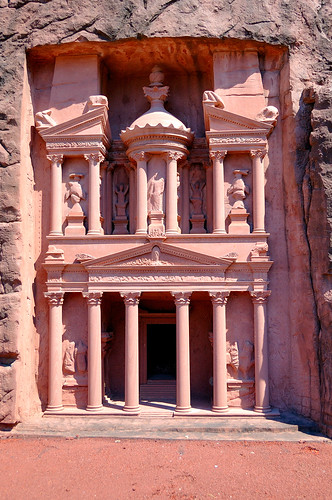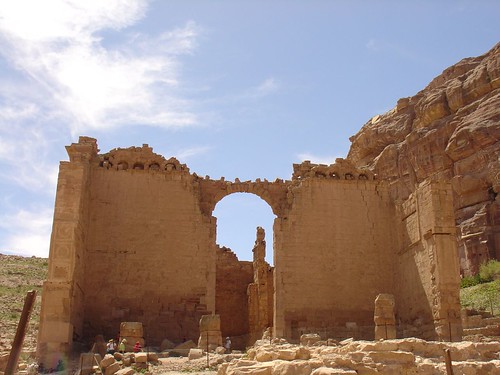Jordan is usually a special tourist destination for lovers of archeology and adventure tourism. One of her special jewel is the wonderful city of Petra, winning second place in the New Seven Wonders of the World in 2007, establishing himself as one of the historical and tourist attractions valued worldwide.

Photography by annia316
The name was given to this ancient city, is directly related to the nature of the site. Petra is a Latin word in Spanish means stone, and not just the city stands on the stone, but part of it. Large Stone Mountain explain this phenomenon caused by the human hand, showing a huge city composed of a rich and delicate architecture product of enormous carved stones. Thus one can see in front of a building massive giant with large columns, capitals and other architectural elements that arise from the same rock, forming an incredible landscape and unusual.
This settlement is located on a narrow valley near the Arava Valley, stretching east between the Dead Sea and the Gulf of Aqaba. It is estimated that the city was founded during the seventh century BC by the Edomites, an important rule that dominated the area for many centuries. A century later, the area was occupied by the Nabataeans, Petra doing prosper in an extremely important, after making its capital. The city kept growing because of its dependence on routes to market their way into Syria, Egypt and Saudi and other areas adjacent to the Mediterranean.

Photography by filip1
Many centuries later, probably around AD VIII trade routes changed their course, leaving in oblivion to the city of Petra, in the rubble that produced the numerous earthquakes that hit the area. This state continued until 1812, at which time Western archeologist Johann Ludwig Burckhardt rediscovered the city, exposing to light the elements which survived the geographical and time.
Its important buildings show traces of time passing and the influence of the different kingdoms and cultures that inhabited the area, bringing with her style and wealth in each of the buildings. Thus, then we can find a set of twenty called jinns rocks which have some ancient religious significance, probably representing the gods are like sentinels guarding the old city. They are also graves around Petra, formed by large facades of Hellenistic influence.
On the other hand, one can appreciate the presence of a large Roman theater, which was built in the first century, completely carved into the rock, in conjunction with masonry, following the tenets of Roman construction. The same could be convened between 3,000 and 8,500 people to enjoy the shows that are taught at the farm along overlapping levels in a crescent around a central conductor. This construction was discovered in 1961por American archaeologists.
As Byzantine influence, you can find many copies of it over Petra. This especially reflects the emergence of numerous churches and stones covered with marble brought from Greece and Egypt. The most famous of all is called the Byzantine Church, built in the V century, reaching north from the famous street of the columns. It was recently discovered, in 1990, suggesting its wonderful architecture. It ensures that the building was decorated with glass and stone, even in some sectors, covered with gold leaf.

Photography by amanderson2
His style is characterized by an architecture rather important Greco-Roman with details inspired by the city of Petra, its vegetation and fauna. Unfortunately, in the late V a devastating fire burned the church, destroying the marble that was of majesty. Their signs were scattered throughout the area in more than 4,000 fragmented pieces, as well as a large number of papyri that were in an ongoing construction site belonging to a noble family.
Other sites such as Qasr al-Bint (one of the main temples of the city that was destroyed by an earthquake and recently rebuilt), the Khazneal-Firaun (Petra’s main street) and the monumental Siq have no waste, as part tourist attractions of the city.
Finally, with regard to museums, you can find two of great importance in the city. One is the Petra Archaeological Museum located in a strange cave on the hill Nabataean al-Habis. The same holds collections from different periods, which are gradually moving into the Petra Nabataean Museum. The latter has a large exhibition of the history of Petra, showing the influences of the Nabataeans in the area and how, thanks to them, the city prospered and was able to become one of the most beautiful in the world. Also remember that the area that houses the old city of Petra is also since 1993 part of the National Archaeological Park.
Thanks to its numerous buildings that are carved into the stone and its important historical character, the city of Petra is part of UNESCO’s World Heritage since 1985.
Leave a Reply
You must be logged in to post a comment.
Recent Comments